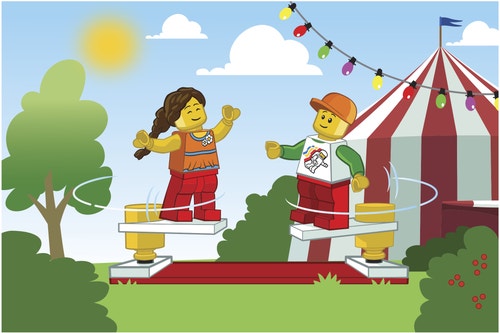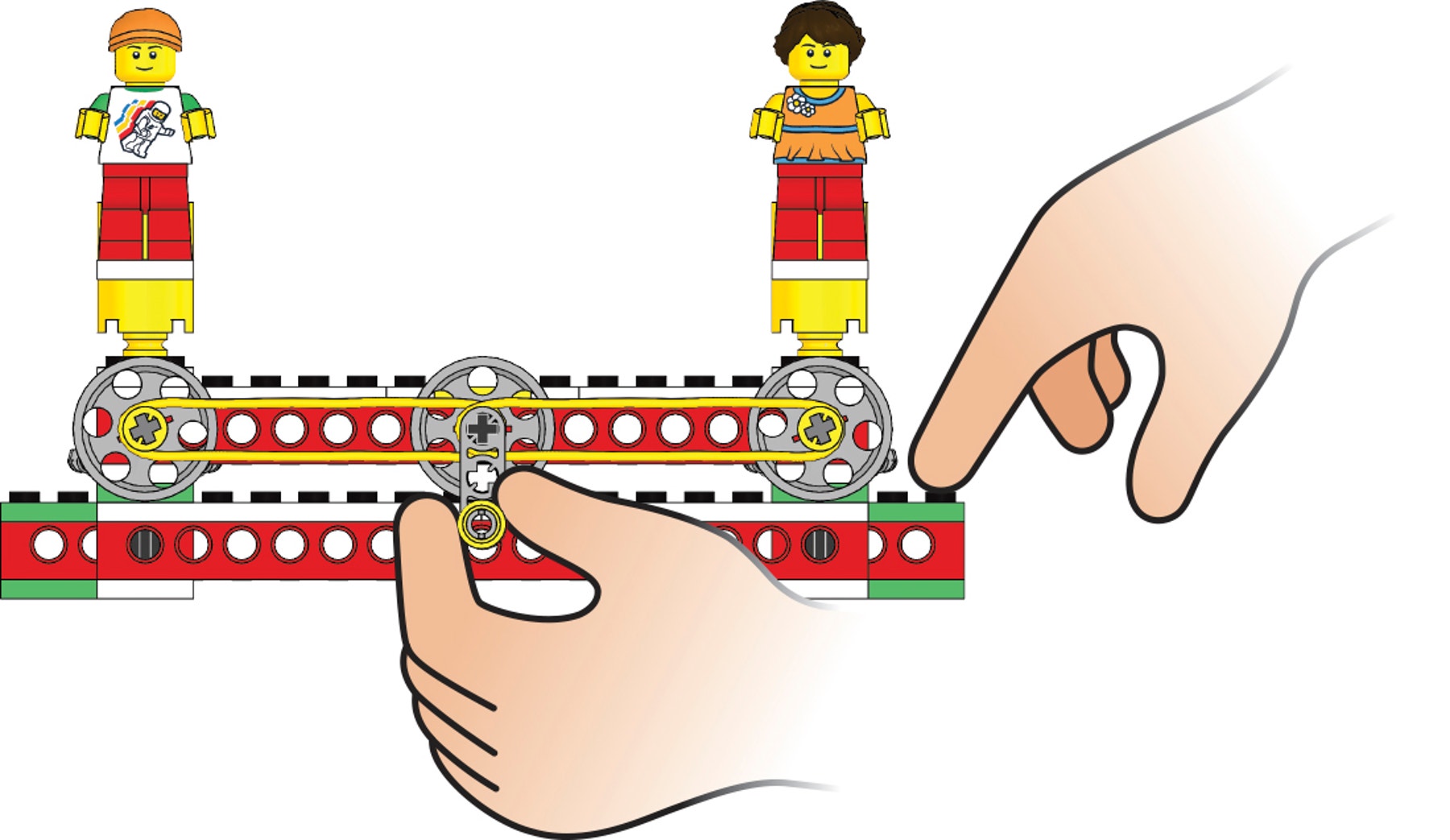Crazy Floors
Explore and recognize that the turning ratio of one pulley to another is determined by the size of the pulleys.

Connect
(5-10 Minutes)
Sam and Sally love going to the fair. There is a fun attraction where you have to have good balance. The floors are crazy! They move at different speeds of rotation and in different directions. It is fun turning and trying not to get dizzy or fall down.
Are you good at keeping your balance?
Have you ever seen floors move?
Which simple machine is needed for Crazy Floors to turn?
Let’s build Crazy Floors!

Construct
(10-15 Minutes)
1. First, build Crazy Floors Model D6 and make it turn.
Follow Building Instructions D, pages 34 to 54, steps 1 to 22.
When Crazy Floors Model D6 has been built, check the following:
Crank the yellow handle to make the crazy floors turn.
Make sure Sam and Sally are attached securely.

Note:
Make sure Sam and Sally are placed as shown on the model.

Hint
Learners should be reminded that the drive wheel is the pulley turned by an outside effort, in this case your hand cranking the yellow handle.
Contemplate
(10-15 minutes)
2. Count the number of pulley wheels on the model.

There are seven pulley wheels built into the model; three large grey pulley wheels
and four small yellow pulley wheels.
3. Then look carefully at the pictures of the models and compare Crazy Floors Model D6 to Crazy Floors Model D7.
Circle what is different.
What do you notice? Explain how the models are different.
Learners should notice the difference in the way the pulleys are arranged on
model D6 compared to model D7.
4. Next, look carefully at the pictures of the models and make a prediction.
If I compare model D6 to model D7, then I think Crazy Floors Model (D6/D7) will show the larger difference in turning (speed of rotations) between Sam’s side and Sally’s side.
Encourage learners to discuss the effects the different pulley arrangements have on the crazy floors in their own words. For the prediction, the correct answer is model D7, as it will show a difference in the speed of rotation of the crazy floors on each side of the model. Model D6 has a ratio of 1:1 and both sides of the model will move (turn) at the same speed. However, it does not matter whether learners get the answer right or wrong at this point, only that they should make a prediction that can be checked later.
5. Test Crazy Floors Model D6.
If you want Sam or Sally to make a full turn, how many times must you crank the handle? Have learners observe the starting point of the handle and both Sam’s and Sally’s starting positions on the crazy floors. *Encourage them to try more than once, to ensure that their observations are correct. Learners must write their answer in the blank box beside the handle.
The learners will have to crank the handle approximately four times for Crazy Floors Model D6 to turn once, but due to slip answers may vary. If learners have worked with the principle models for gears, they should be made aware that the angled gearing below the crazy floors enables the rotary motion to be transmitted through a 90-degree angle.*
Note
If possible, keep an example of Crazy Floors Model D6 for learners to compare with Crazy Floors Model D7.
6. Build Crazy Floors Model D7 and make it turn.
Follow Building Instructions D, page 56, step 1.
Gently grip one of the floor elements to stop it from turning, and you will feel the pulley belt slip.
Encourage learners to identify parts while they are testing the model. Learners can be made aware of 'slip’ (see Glossary) by gently gripping the floor element to prevent it from turning, as this causes the attached pulley belt to slip.

7. Test Crazy Floors Model D7.
Which side of Crazy Floors will move the fastest, Sam’s side or Sally’s side?
Have learners pay attention to the starting positions of both the handle and the minifigures. Encourage them to try more than once, to ensure that their observations are correct. Learners must write an F for fast and an S for slow. The different pulley arrangements produce different speeds of rotation for Sam and Sally. The drive wheel is attached to the handle, and there is thus a gearing up pulley arrangement to the side where Sam stands. Sam turns at a much faster pace (= F, for fast) than the gearing down pulley arrangement on the side where Sally stands, which turns at a much slower (= S, for slow) pace.
8. Finally, draw a conclusion and check your prediction.
Crazy Floors Model D7 has the larger difference in the speed of rotation of the crazy floors because of the different pulley arrangements.
Continue
(10-15 Minutes)
Learners are encouraged to explore the pulley arrangements illustrated on the Learner Worksheet and to record their observations.
Note
There are no building instructions included to guide learners through the Continue phase, other than the illustrated suggestions on the Learner Worksheet.
Encourage your learners to discuss the effects the pulley arrangement will have on Crazy Floors in their own words, prompting them with questions such as:
- Describe what happened when you turned the handle.
- How many times did you have to turn the handle to make the crazy floors turn once?
- Why do you think that was?
- Describe how the model works.
- What did you do to make sure your observations were correct?
It is suggested that learners should draw items where they find pulleys used in everyday machines and mechanisms.
Optional
With more advanced learners, you might consider introducing compound belt drives. Pulley wheels of two different sizes on the same axle can be connected to other pulley wheels to build more extensive gearing down (and gearing up) arrangements.
Teacher Support
Students will investigate:
Pulley wheels
Models which will gear up and increase speed of rotation
Models which will gear down and decrease speed of rotation
Predict outcomes of various trials
9689 Simple Machines Set (one set per two students is recommended)
Pupil Material
Share with:
 Google Classroom
Google Classroom



